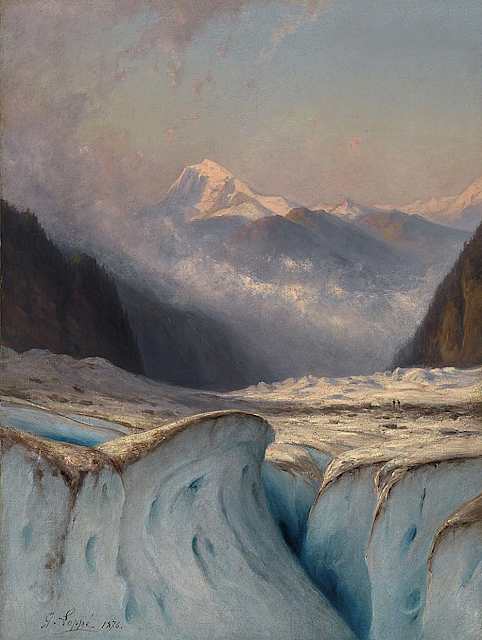Matterhorn / Cervin/ Cervino (4,478m -14,691ft)
Suisse - Italie
In " Le Cervin vu de Riffelsee, huile sur toile, Courtesy John Mitchell Gallery London
La montagne
Le Cervin (4,478m -14,691ft) appelé aussi Matterhorn et Cervino) est le 12e sommet des Alpes en atltude. Il est situé sur la frontière italo-suisse, entre le canton du Valais et la Vallée d'Aoste. Il donne sur la ville suisse de Zermatt au nord-est et la ville italienne de Breuil-Cervinia au sud. Il relie la vallée de Zermatt et le Valtournenche, dans le Val d’Aoste, par le col de Saint-Théodule, à l’est. Le Cervin est la montagne la plus connue de Suisse, notamment pour l'aspect pyramidal qu'elle offre depuis la ville de Zermatt, dans la partie alémanique du canton du Valais. Son image est régulièrement utilisée pour les logos de marques commerciales. L'ascension par l'arête du Hörnli, le 14 juillet 1865, est considérée comme le dernier des grands exploits de l'alpinisme dans les Alpes. Mais cette ascension réalisée sous la conduite d'Edward Whymper se solde, au début de la descente, par la mort de quatre des sept membres de la cordée victorieuse. Sa face nord est l'une des trois grandes faces nord des Alpes avec celles de l'Eiger et des Grandes Jorasses.
Le peintre
Gabriel Loppé est un peintre français, photographe et alpiniste qui est devenu le premier étranger membre du Club alpin britannique de Londres. À 21 ans, il grimpe une petite montagne dans le Languedoc et y trouve un groupe de peintres qui en esquisse le sommet. Ce jour-là, il trouve sa vocation. Il se rend ensuite à Genève où il rencontre le chef de file suisse des peintres paysagistes, Alexandre Calame (1810-1864). Loppé s'initie à l'alpinisme à Grindelwald dans les années 1850 et se fait facilement de nombreux amis parmi les alpinistes anglais en France et en Suisse. Bien qu'il soit souvent étiqueté comme un élève de Calame et de son rival François Diday, Loppé est plutôt un artiste autodidacte. Il est devenu le premier peintre à travailler à haute altitude, profitant de ses expéditions et gagnant le droit d'être considéré comme le fondateur de l'école des peintres-alpinistes, qui s'est établie en Savoie à la fin du 19e siècle. Ses peintures sont aujourd'hui célèbres pour leur atmosphère et leur spontanéité et sont exposées régulièrement à Londres et Paris. En 1896, Loppé aura passé plus de cinquante saisons d'escalade et de peinture à Chamonix. Parmi les disciples notables de Loppé, on compte Charles-Henri Contencin (1875-1955) et Jacques Fourcy (1900-1991). Ils se retrouvèrent ensemble pour la première ascension du Mont Mallet (un sommet du massif du Mont-Blanc) par la voie des Grandes Jorasses à Chamonix, Loppé fit également plus de quarante ascensions du Mont Blanc au cours de sa carrière d'alpiniste, qui a duré jusqu'à la fin des années 1890. Il a souvent fait des croquis à l'huile des sommets alpins, y compris un panorama depuis le sommet du Mont Blanc. Une exposition itinérante nommée "Voyages en montagne" a été consacrée à l'œuvre de l'artiste en 2005-2006 aux musées d'Annecy, de Chambéry et de Gap.
Dans ses dernières années, Loppé est pris d'une fascination pour la photographie et a même beaucoup innové dans ce domaine. Sa photographie de la Tour Eiffel frappée par la foudre fait maintenant partie des collections du Musée d'Orsay à Paris.
_________________________________________
2023 - Wandering Vertexes ....
Errant au-dessus des Sommets Silencieux...
Un blog de Francis Rousseau
-%20The%20mattherhorn%20from%20%20Riffelsee-%20John%20Mitchell%20gallery%20London%20.png)









